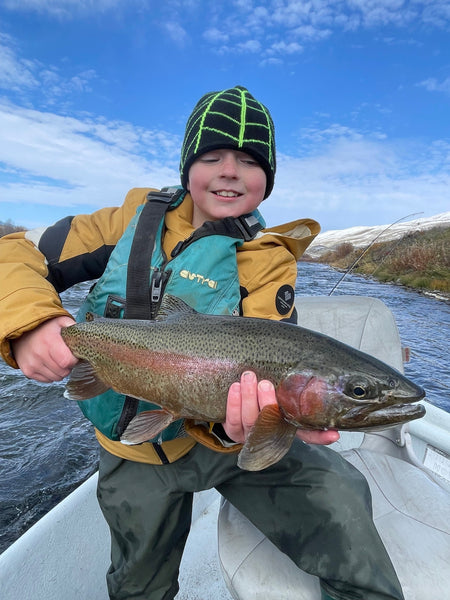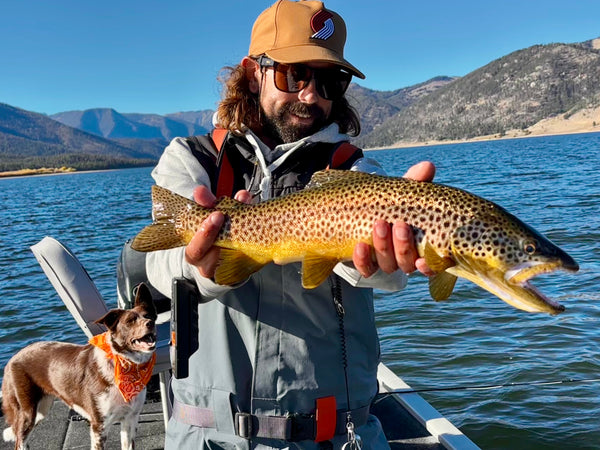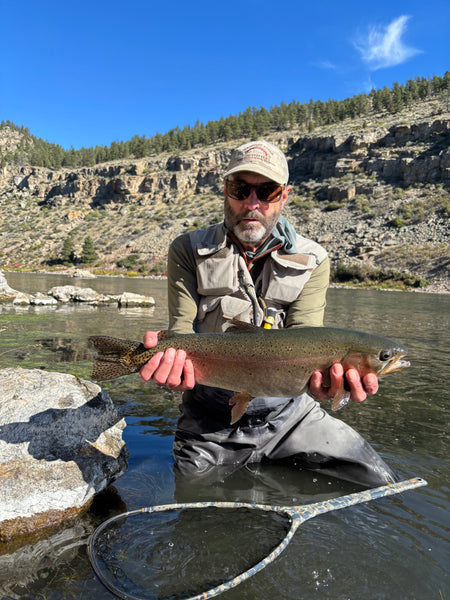Trout Fishing With Wet Flies - Part 3
January 29, 2019
Part 3 of 3 Back to: Part 1 Part 2
Trout Fishing With Wet Flies
In our previous posts about fishing wet flies, we covered all the bases to get you on the water at the right time, rigged up the right way. Now we will look at the most important thing of all, how to effectively fish wets, starting with casting, moving onto presentation, hooking the fish, and finally ending with efficiently covering the water.
Regardless of whether you are fishing your wet flies with an eight foot three weight single hand rod or a twelve foot six weight two hander, the most important thing about the cast remains the same. The leader must straighten out fully on the cast. This allows the fly to begin to fish under tension immediately. To insure this, when it is windy, make sure the cast’s turnover point is immediately over the water so the flies are not blown about before they land. Unlike dry fly fishing, slack in the cast is seldom wanted, so it is important to cast a nice straight line.
Even when fishing a single hand rod, I rarely make a back cast when swinging wet flies. Instead I commonly use touch and go single hand spey casts. These casts are quiet and very quick to get the fly back in the water. If done properly they won’t tangle and allow me to cast in any wind. I also don’t need much room for a back cast.
Most of my casts while swinging wets are reach casts. This helps to slow the initial part of my swing and saves me from making mends once my flies are on the water.
The cast is the first part of the presentation, the goal of which is to fish the flies around on a smooth swing without a great belly in the line. The angle of the cast determines a lot of how the fly will fish throughout its swing. The more across stream the cast is made, the faster the fly will initially fish. Casting downstream at a steep angle makes for a very slow swing. Casting closer to 90 degrees straight across means more water is being covered with each cast. Each water type is different, but a good rule is to cast close as you can to a 90-degree angle without the line bellying immediately at the start of the swing and minimal mending is required. Usually this ends up being a cast angled across and slightly down at an 80-65 degree angle.
After the cast lands I hold the rod tip up above the water and pointed out in the river. Holding the rod tip up does two things for us. First off, this slows first part of the swing as it keeps the line off conflicting currents. Secondly, holding the tip up allows for a little give in the line so the fish can inhale the fly.
As the fly hits the water I may make one mend to keep a big belly out of the line. I want to feel tension on the line building as quickly as possible. A fly under tension has action and life. I mend upstream and HOLD the tip of the rod upstream of my fly line as it swings. This is a different mend than I make while fishing dries or nymphs where I am trying to introduce slack to allow my flies to dead drift. When fishing wets the purpose of the mend is to realign the fly line in the current, rather than producing slack with my mends. If I do mend, it is only at the beginning of my swing. Other changes in how my fly fishes are made by either leading or following my line with the rod tip during the swing.
As the fly begins to come around, I keep the rod tip up, but begin to draw an arc with the rod tip towards the inside of the swing. I should feel the line pulling on the rod tip throughout, but I don’t want to feel as if I am pulling my drift with the rod tip. If I want to slow the swing, I keep the tip of the fly rod behind or outside of the line during the swing. If I want to speed things up I begin to lead my swing, pointing the rod tip slightly inside of the line to where the fly is headed. In fast water I slow things down, slow water I’ll speed things up.
Most folks I see fishing wets pay very little attention to how their rod position affects their swing speed and fly action. They cast and simply hold on. By mending, lifting, leading or following you can have a dramatic impact on how your fly fishes. Generally I am trying to slow the early part of my swing and speed the last bit to keep the fly swinging at a consistent speed. However, the water I am fishing and how the fish react to my fly always determine how I seek to fish my fly.
As my fly is swinging, there are four different retrieves or actions I put on my fly. First is doing nothing, allowing the currents to animate the materials in the fly. Second is a soft rod tip bounce to pulse the fly as it swings. This can be done by moving the rod up and down or pulling the rod towards our body then pushing it back towards the fly. The third action I put on the fly is pulls or twitches with my non-rod hand. Lastly I’ll use a slow hand twist retrieve that smoothly pulls or swims the fly through the swing. I am trying to make the fly look alive and seductive. Quick hard movements are usually avoided.
When fishing, I often try all four fly actions, decide which is most effective that day or for that water type and then stick to it. In slower water some action on the fly is normally most effective. Even in fast water a retrieve or pulses on the fly can add up to a lot more fish. The best day of soft hackle fishing I had last season at Raynolds’s Pass in the fast pocket water of the Madison fish preferred a hand twist retrieve after a sharply angled cast down into the various pockets I fished. Again, switch up how your fly is fishing until the fish tell you what they want.
Hooking the fish
When the fish eat the fly you will feel the take. Try to keep the rod tip up a bit throughout your flies swing as this will help give the fish a bit more give when they eat the fly. A dead straight line can prevent the fish from actually getting the fly into their mouth. Most trout takes on swung flies; unlike Steelhead or Atlantic Salmon are quick affairs. The fish eats the fly and either hooks itself instantly or does not. There usually isn’t a slow building of tension on the line or various pulls and tugs leading to the actual hook up.
When the fish takes, it is most important to NOT SET THE HOOK. Jerking the rod tip up in most cases pulls the flies directly out of the fishes’ mouth. Instead of jerking, simply allow the fish to eat the fly then gently raise the rod once the weight of the fish is felt. Some days you will hook a lot of the fish that eat, some days the fish just don’t seem to stick. There isn’t much you can do, aside from fully allowing the fish to eat the fly to put the odds in your favor.
The most important aspect of soft hackle fishing is to cover water. Fishing wets on the swing is a method for targeting active fish and isn’t a good method for prodding unwilling fish into taking. When guiding I often tell my anglers to not bore the fish. KEEP MOVING! If a fish didn’t eat it the first cast, they probably won’t eat it the second or third. Rarely do I make two casts with my feet in the same position unless it is to try a different action on the fly over the same spot. Most of the time I work my way downstream, taking a step or two between casts. Less promising water I will fish through quickly with several steps between casts. One nice thing about soft hackle fishing is that you don’t disturb the water much, provided you wade as minimally as possible. I’ll often fish through a good run quickly and then change flies and make another pass. This is a much better use of time than standing in one spot repeating the same presentation over and over to the same water. Usually there is a direct correlation between the amount of water covered and the number of fish encounters had. Keep moving and hunting for biters.
With the right rig and a good presentation we can be successful fishing soft hackles throughout the majority of our trout fishing season here in West Yellowstone. Next time you are on the water, give the method a shot.
Back to: Part 1 Part 2
About Mike Loebl - Professional Fly Fishing Guide at Madison River Outfitters, West Yellowstone, MT

Mike began fly fishing at the age of 7 in his home state of Michigan, where he would later start his career in the industry at a fly shop in Northville. Fast forward to the present and Mike has been with MRO for the better part of the past two decades. Not only is Mike a certified FFF casting instructor, but he is also well versed in both spey casting and Czech nymphing. As a guide, Mike loves to teach people new techniques and help improve upon what they already know. When not fishing, Mike can be found spending time with his wife Alice Owsley (also a fly fishing guide in the area) and their dog Norman.
Leave a comment
Comments will be approved before showing up.
Also in Madison River Fishing Report - Upper Madison River Fishing Report - Greater Yellowstone Area Fishing Reports

Madison River Outfitters Fishing Report for 10/21/2025
This is the Last Report of the Year! Have a Great Winter, and We'll See You All This Spring!!






Mike Loebl
Author